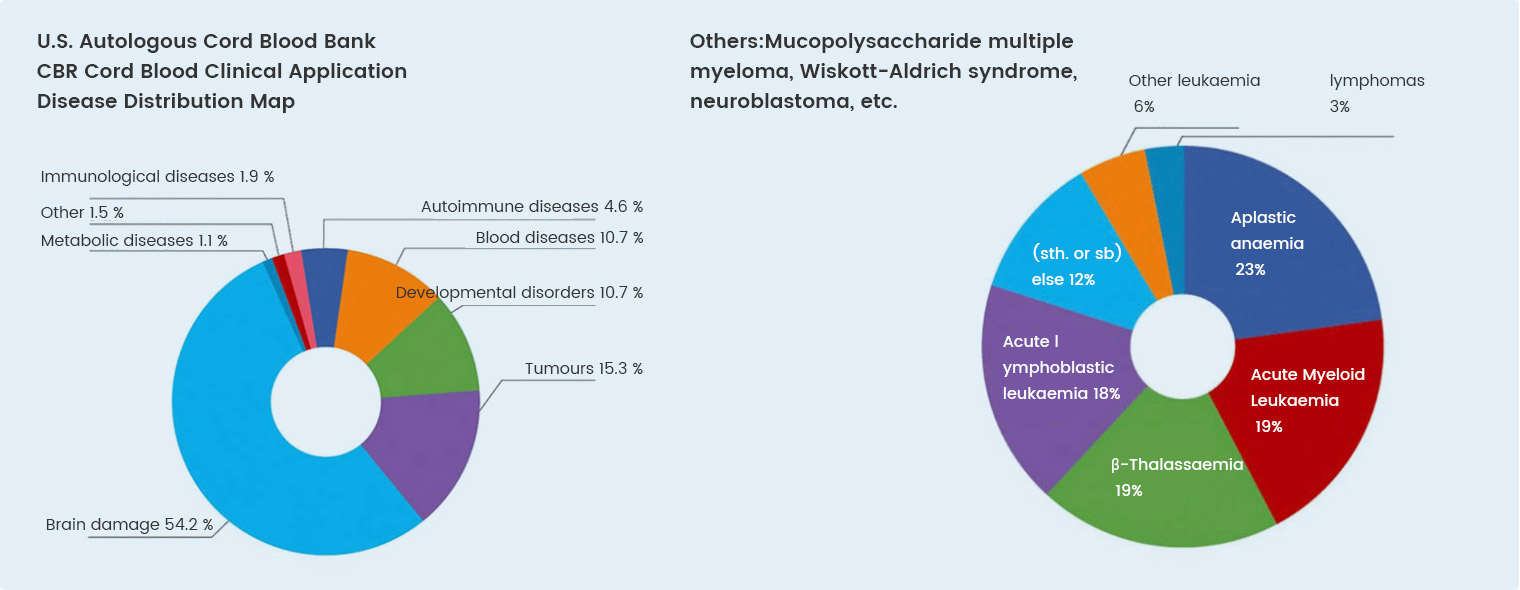What Are Umbilical Cord Blood Hematopoietic Stem Cells?
Umbilical cord blood hematopoietic stem cells are a population of primitive, highly undifferentiated cells that give rise to all blood cell, including erythrocytes, leukocytes, platelets, and immune cells These cells are collected from the umbilical vein after cutting the umbilical cord. Autologous transplantation for the baby requires no HLA matching, and the matching rate is high for transplants among genetically related family members.
Clinical Application of Umbilical Cord Blood Hematopoietic Stem Cells
According to relevant national regulatory documents, the indications for umbilical cord blood hematopoietic stem cell treatment include:
1. Hereditary and congenital diseases: Bone marrow failure, hemoglobinopathies, severe immunodeficiency diseases, and metabolic diseases.
2. Acquired diseases:
(1) Malignant diseases: Acute leukemia, chronic leukemia, myelodysplastic syndromes, multiple myeloma, malignant lymphoma, and other specified malignant tumors.
(2) Non-malignant diseases: Severe aplastic anemia, severe radiation sickness.
Since the first successful use of umbilical cord blood in 1988 by Gluckman for the treatment of Fanconi anemia in siblings, umbilical cord blood hematopoietic stem cell transplantation has gained increasing recognition and has become an effective alternative to allogeneic hematopoietic stem cell transplantation, demonstrating significant potential.
With advancements in biotechnology, there are more than 1,000 registered clinical trials of umbilical cord blood hematopoietic stem cells worldwide for the treatment of more than 80 hematologic and non-hematologic diseases (e.g., lupus erythematosus, Crohn's disease, autism, cerebral palsy, and spinal cord injury). Globally, umbilical cord blood has been used in over 40,000 patients in clinical practice, of which more than 5,000 cases originate from China.

Distribution of diseases treated with umbilical cord blood: Data from the U.S Cord Blood Registry (CBR)
● Immune diseases 1.9%
● Others 1.5%
● Metabolic diseases 1.1%
● Brain damage 54.2%
● Autoimmune diseases 4.6%
● Hematologic diseases 10.7%
● Developmental disabilities 10.7%
● Tumors 15.3%
Others: Mucopolysaccharidosis, multiple myeloma, Wiskott-Aldrich syndrome, neuroblastoma, etc.
● Other leukemias 6%
● Lymphoma 3%
● Others 12%
● Aplastic anemia 23%
● Acute lymphoblastic leukemia 18%
● Acute myeloid leukemia 19%
● β-Thalassemia 19%
Advantages of Umbilical Cord Blood Hematopoietic Stem Cell Transplantation
Compared with unrelated donor bone marrow transplantation, umbilical cord blood transplantation offers the following advantages:
1. Abundant source of umbilical cord blood;
2. Easy to collect, without causing any harm to the mother and fetus;
3. Unlike unrelated donor bone marrow registries, umbilical cord blood is cryopreserved as a physical product and will not be rejected by donors;
4. The time required to search for HLA-matched umbilical cord blood hematopoietic stem cells is short, enabling timely transplantation based on patient needs;
5. Due to the presence of immature immune cells in umbilical cord blood, both acute and chronic graft-versus-host disease (GVHD) occur less frequently and with milder severity post-transplantation. Umbilical cord blood hematopoietic stem cell transplantation allows greater tolerance for HLA mismatches, consequently requiring fewer donors in the cord blood bank compared to bone marrow registries;
6. Umbilical cord blood has a lower risk of viral infections, resulting in reduced risk of post-transplantation viral disease.
Significance of Autologous Umbilical Cord Blood Hematopoietic Stem Cell Storage
The stored autologous umbilical cord blood hematopoietic stem cells can safeguard the health of both the child and family members. For hematopoietic stem cell transplantation, autologous hematopoietic stem cells guarantee a 100% HLA match, while offering a > 25% full-match probability with siblings and at least a haploidentical match with parents. This presents a significant advantage over allogeneic transplants, where the matching rate is only 1 in 50,000–100,000. The probability of HLA matching directly determines the chance of successful transplantation. Therefore, the storage of autologous placenta blood hematopoietic stem cells actually secures an indispensable health guarantee for both the child and the entire family.

Mom, have you stored your baby's placenta blood?







